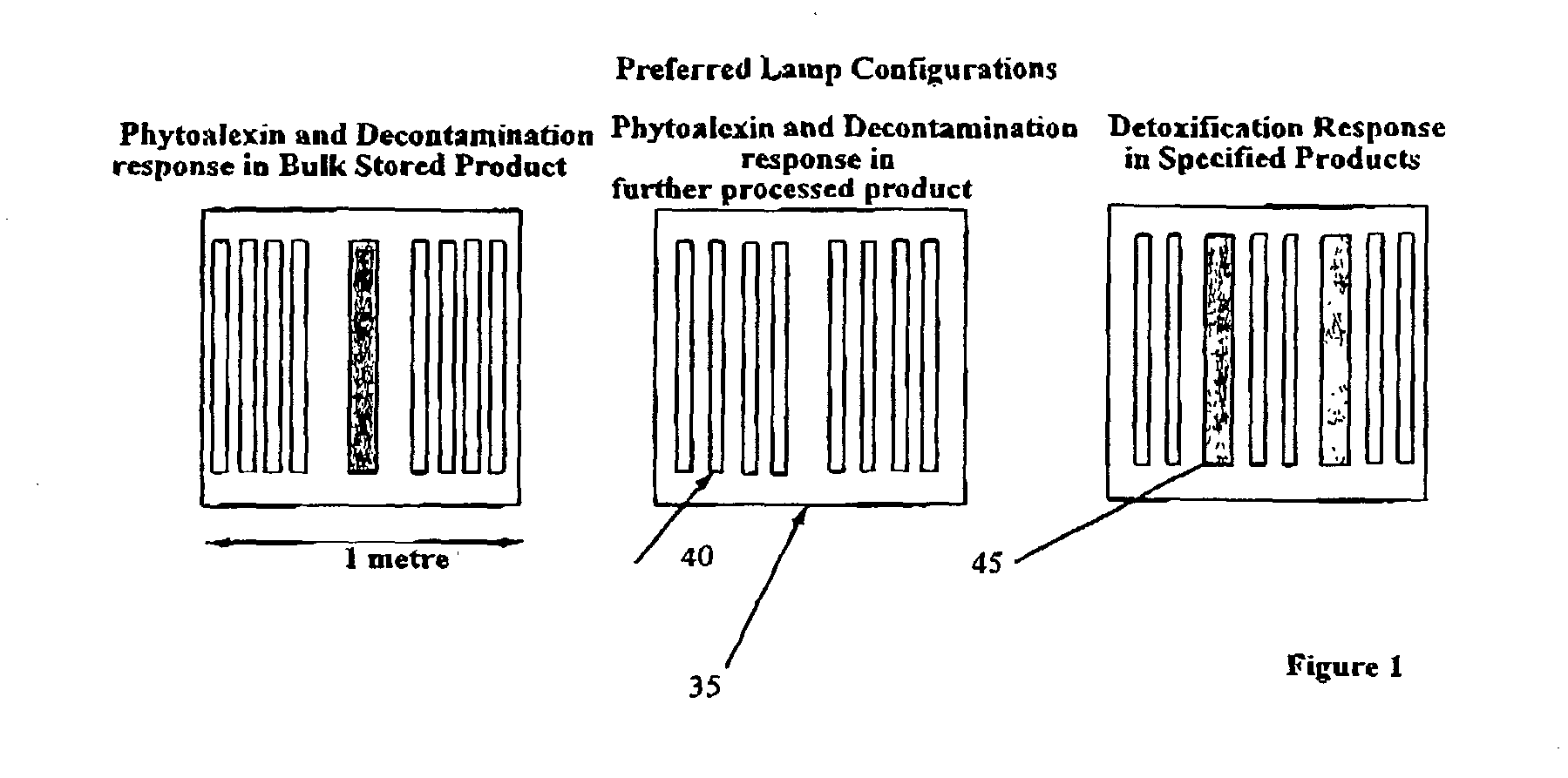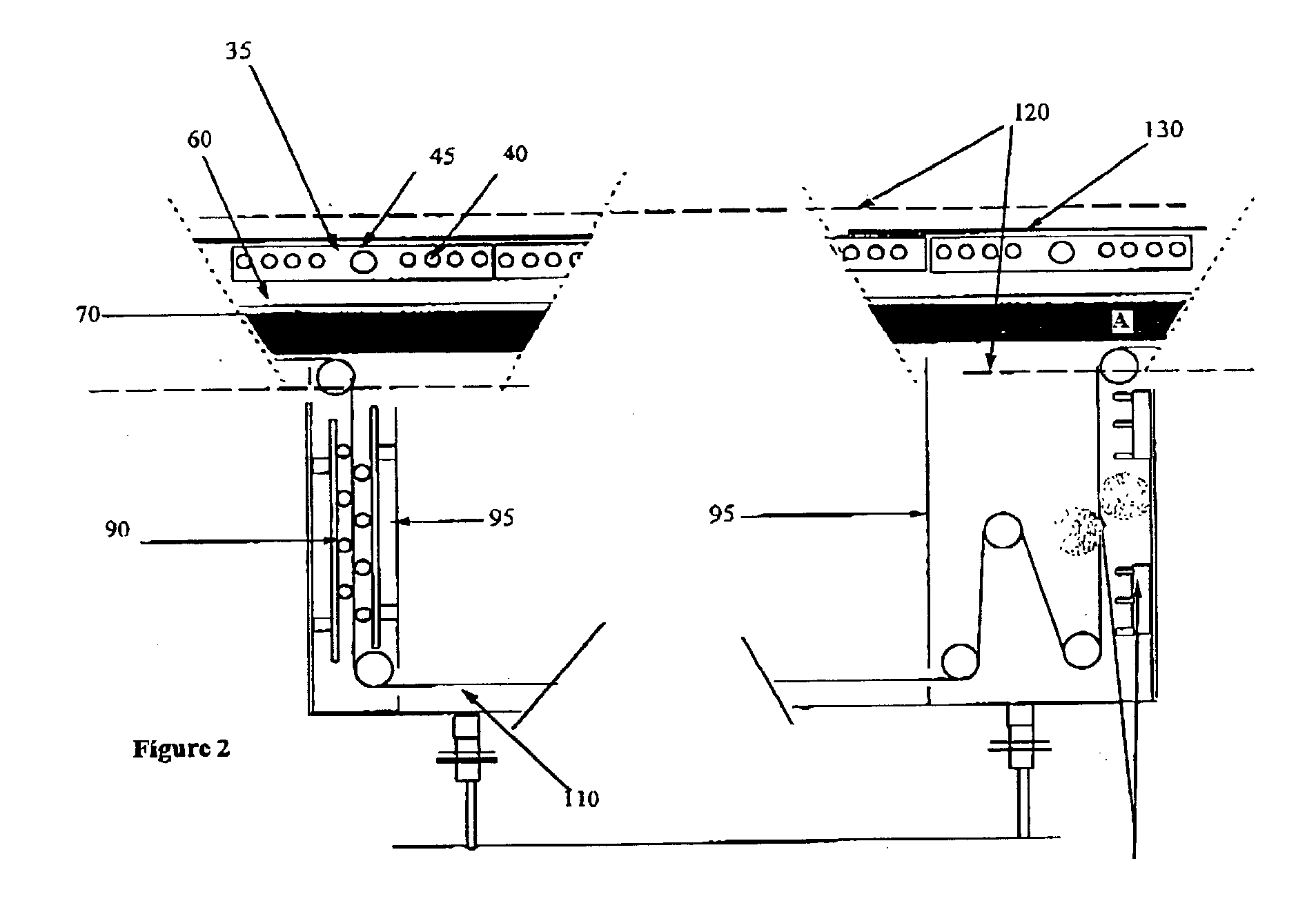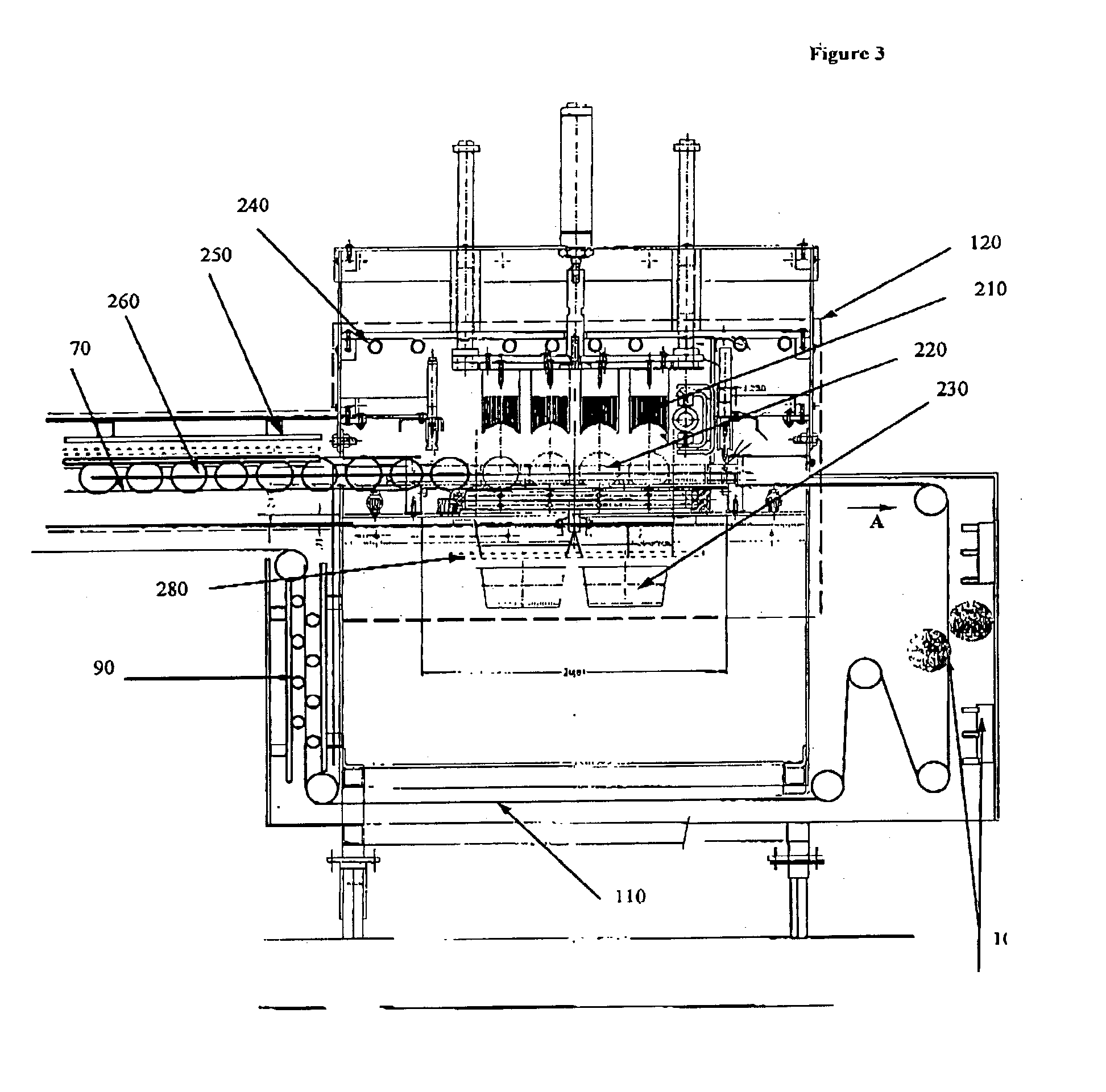However very considerable amounts of stored foodstuffs are lost due to
b) the production of secondary toxic metabolites (aflatoxins) which are harmful to the health of both humans and animals and, once formed are difficult and / or expensive to remove.
The problem with the former is that they are directly caused by microbial
contamination of the
crop at harvest or at storage and remain undetected until the
crop is removed from storage for
processing into food materials and products or are resistant to attempts to remove it during the further processing stages of manufacturing.
While stored crops are often held in modified atmospheres or
forced air flows to make the atmospheric conditions and
humidity levels less suited to microbial growth and consequent stored product deterioration, these approaches merely reduce the rate of spread of
contamination and have little effect on the total level of contamination certainly from the incoming
crop.
Aflatoxins are metabolites of microbial growth and what makes them particularly dangerous is that once generated they remain accumulated in the fruit, nut, grain or vegetable long after any signs of the original infection may have disappeared.
Another problem with microbial contamination and subsequent aflatoxin formation is that it is extremely variable.
However the
fluorescence technique is far from foolproof and false positives and variable performance both between and within different crop groups are a major problem.
Again while they undoubtedly cause a reduction in total crop aflatoxin levels they do not eliminate it and further expensive
remedial action is often necessary before the product is safe to release into the
human food chain.
Also, these methods are crop specific and practical application is restricted to only a few of them.
Although making a significant improvement to the detection of contaminated harvested crops, the technique is variable in performance and far from reproducible.
Accurate batch sampling of large volumes of incoming material is notoriously difficult to do, is expensive and
time consuming and no way guarantees that the product will emerge from the manufacturing process in an aflatoxin free condition.
This therefore causes still further expense and
delay while the finished product is similarly re-analysed.
Should any contaminated product be discovered at this stage (
pathogen or aflatoxin), it necessitates further expensive reprocessing to inactivate the aflatoxin.
However such techniques are either very expensive and only warranted for that part of the crop which could be designed as premium product and thus generate sufficient margin to make its further
processing cost effective or they cause the partial degradation of the product quality and thus depress the selling capability or they are only partially effective.
However most of these treatments can or do have effects on the foodstuff which leads to a reduction in some measure of their quality attributes usually due to either oxidative and / or hydrolytic reactions within or upon the surface of the foodstuff.
An alternative approach has been the use of
physical media such as pulsed light in conjunction with photosensitisers such as
riboflavin or isoalloxazine (Hlavinka, 2001, Doyle et al 1982).The inactivation of the
pathogen occurs by interfering with replication but this does not inactivate the aflatoxin and, as has been shown elsewhere with other pathogens such as E. coli, rupture of the
pathogenic organism may lead to an excessive release of
toxin and a
resultant more acute toxicosis.
However even in neutral solutions the presence of strong oxidisers such as bisulphites, hypochlorites or peroxides will lead to
aflatoxin degradation.
Unfortunately this usually only occurs in reasonable time (2 hours) at elevated temperatures of 40.degree. C. or greater at additive concentrations of 1% or greater.
Commonly used fumigants showed no detoxification capabilities (Brekke and Stringfellow, 1978) Another drawback to
effective treatment using such additives is that it frequently requires the foodstuff to have either an elevated
moisture content or a high
water activity for significant detoxification to occur.
Nor can they be subjected to
thermal energy which would change their composition, state or appearance.
It is further known that most food contaminations occur on or very close to the natural surfaces of the foodstuff or are generated on or near the surfaces of foodstuffs undergoing processing as a consequence of the action of manufacturing processes themselves, such as peeling,
cutting,
slicing or cubing, on the foodstuff.
It is known that
sunlight is capable of significantly reducing aflatoxin levels in liquid media but its performance in
solid media is much lower and variable.
We are aware that the lamps and lamp configurations we use also generate small amounts of
Ozone.
However the levels produced are very low and we have demonstrated that because of the refrigerated
air cooling system used around the lamps (to keep them within optimum performance conditions), the fact that the lamps themselves are physically separated from the foodstuff both by
quartz glass sheets and the enclosures within which they operate, none of the produced
Ozone comes in contact with the foodstuffs or the
atmosphere around the foodstuff.
In any operation which processes large volumes of agricultural or horticultural foodstuffs, there is a very high volume of
dirt, sand, damaged or decaying produce and other highly contaminated physical
detritus in
close contact with the foodstuff to be processed.
While this is accepted as a
normal component of harvested produce and to a lesser extent (as a result of physical methods of removing it such as washing or sifting) in
bulk storage of such products, it is highly undesirable in further processing operations.
Use of the combination of lamps produces a significant synergism.
Elevated humidities (together with elevated temperatures and catalysts of oxidation reactions) adversely affect product quality.
However although preferred, it is not essential for effective decontamination and / or detoxification.
The use of UV wavelengths of the type previously described, particularly when produced from
medium pressure mercury lamps, generates excessive amounts of heat (typically 50% or more of the
total energy output).
Almonds, other nuts and other fruits, grains and vegetables with a high level of natural anti-oxidant need much less rigorously controlled temperature requirements with temperatures in excess of 40.degree. C. at the surface not resulting in any detectable deterioration in the physical or
chemical state of the product.
We have shown that it also makes them significantly more susceptible to the decontamination treatment than if the same treatment is undertaken without the modification to the
atmosphere.
Secondly reducing the amount of available
oxygen at the surfaces at the time of
exposure to the UV sources, reduces or inhibits oxidation reactions occurring.
However the rate and amount of oxidation that occurs varies both between foodstuffs and treatment conditions.
We have shown that even if all other conditions are met, the treatment will be less effective and more variable if proper spacing and placement of foodstuff is not induced and maintained.
UV wavelengths of light have poor penetrative capabilities with the ability to penetrate decreasing with decreasing
wavelength of UV light.
 Login to View More
Login to View More 


